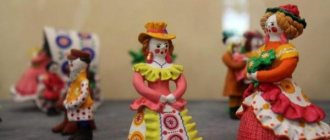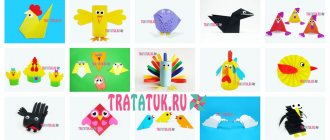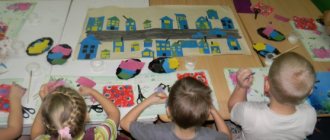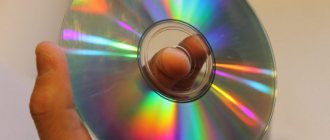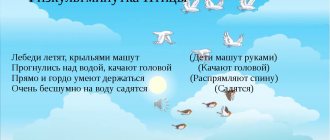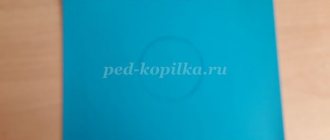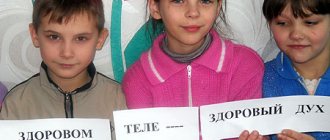Lesson summary on application (HLS)
Topic: “Vitamins are my best friends”
Software tasks:
- Arouse children's interest in a conversation on a certain topic.
— Fix the names of the colors (red, green, yellow)
— Introduce the vitamin properties of vegetables and fruits.
— Continue to cultivate responsiveness, kindness, and empathy in children.
— To develop children’s interest in applique, to strengthen the ability to use a brush when applying glue.
Materials and equipment:
A sheet of paper in A 1 format with an image of a basket, blanks of fruits and vegetables cut out of colored paper, glue pencil, napkins, pictures of polar bears, Doctor Aibolit.
Contents of the lesson
:
Educator
: Far, far in the north, where there is always winter and snow, polar bears live. They got into trouble and got sick. The cubs had a fever and a sore throat, and the mother bears put thermometers on them. Then the cubs remembered about Doctor Aibolit, who treats everyone in the world.
Treats small children
Heals birds and animals
He looks through his glasses,
Good Doctor Aibolit.
Educator
: The bears then sent a telegram to Doctor Aibolit: “Dear Doctor Aibolit, hurry up, come here quickly, we are sick.”
He flew on an eagle, through storms and rain, he stood on a rock, not afraid of anything. He came to the cubs and began to treat them. What do you think Doctor Aibolit used to treat the little bear cubs?
Children
: Tablets, syrup….
Educator
: That's right guys! And the cubs soon recovered. Only they were very weak after the illness...
Educator
: (unexpectedly) Oh guys, look, we have a letter! (shows the letter) Who is it from, you need to read it: “Little bear cubs need fruits and vegetables rich in vitamins. Help me guys. Dr. Aibolit".
Educator
: But where can we get so many fruits and vegetables? What should we do? Guys, do you eat fruits and vegetables?
Children
: Yes.
Educator
: Do you know that fruits and vegetables are very healthy, they are rich in vitamins. But each fruit or vegetable is beneficial in its own way. (Song about vitamins).
Educator
: Well, where can we get so many vegetables and fruits to help the bear cubs? Guys, I know! We can help by collecting a whole basket of vitamins. And before we get to our basket, we'll play a little.
We'll squat down
And in the garden we will plant,
Onions, carrots, dill, peas,
Our harvest is not bad!
Educator
: Well done, well, now, we have warmed up and are ready to collect fruits and vegetables!
(Children approach the tables on which whatman paper with a drawn basket, glue, and napkins are prepared!)
At the end of the lesson, the children, together with the teacher, look at what they did! What a big basket they prepared for the cubs. As a surprise, in the end, the teacher brings out a plate of prepared fresh vegetables and fruits for the children to treat!
Summary of GCD in the senior group on the topic of healthy lifestyle
Summary of educational activities in the senior group of a preschool educational institution on the topic “Flower of Health”
Author: Tkacheva Irina Nikolaevna teacher MBOU gymnasium UVK No. 1 in Voronezh Description: I bring to your attention a summary of the lesson “Flower of Health” for the senior group of a preschool educational institution. This lesson helps the child form ideas about health, preventive measures and health protection. Goals and objectives of the upbringing and development of children: 1. Enrich the sensory experience of children, improve analytical perception, develop the ability to identify the properties of objects using different senses. 2. To encourage children to master different methods of examination, to establish connections between the method of examination and the knowable property of the object. 3. To promote children’s mastery of the appropriate vocabulary and its active use. 4. Develop monologue forms of speech, stimulate children’s speech creativity. 5. Develop good feelings, emotional responsiveness, the ability to distinguish the mood and emotional state of people around you and take this into account in your behavior. 6. Promote the formation of a sustainable interest in the rules and norms of a healthy lifestyle, health-saving and safe behavior. 7. To form and activate in children the manifestation of an aesthetic attitude towards the world around them in a variety of situations. 8. Form a conscious need for physical activity and physical improvement. The priority area is cognition. Equipment: multi-colored flower, mnemonic table, mood lamp, clean water, juice, cups, bottles, plates, tubes, multi-colored balls, water containers, baskets with letters (vitamins) A B C, products in the store, fruit juices, fruit : bananas, apples, canned pineapple, pears, disposable knives, cutting boards, badges, white coat for the teacher, aprons. Preliminary work: conversations about a healthy lifestyle, reading stories, poems. Learning proverbs and sayings about a healthy lifestyle, Conversations about harmful and healthy foods, the benefits of exercise, clean air and water. Educator: Guys, guests came to us today, let's say hello to them (children say hello). We didn’t just say hello, but wished the guests good health. What is "hello"? The best of words, Because “hello” means - be healthy - Hello! - you tell the person - Hello! - he will smile back - And probably won’t go to the pharmacy. And you will be healthy for many years. Now let's say hello to each other: Good afternoon - they told you Good afternoon - you answered. You are connected by two strings of warmth and kindness. Health is the most important value given to a person. What does it mean to be healthy? Children: When we are healthy, we want to read, draw, play, study, we are in a kind and friendly mood. Educator: Our health can be compared to a flower that has many petals; these petals live in every cell of our body. (children open the first petal) 1 Petal “Physical exercise” Educator: Physical exercise can replace many medications, but not a single medicine in the world can replace physical exercise (Mosse) Let’s think about what benefits physical exercise brings? Children: Strengthen muscles, harden the body, give us a cheerful, good mood, drive away fatigue. Educator: You and I do exercises every morning, we end the exercises with the words: Children: “Health is fine, thanks to exercise.” “Do exercises every day - you will be strong, you will be brave. Educator: And now we will do self-massage. (“Neboleyka” - biologically active zones) So that the throat does not hurt, We will stroke it boldly. So as not to cough, not to sneeze We need to rub our nose We will also rub our forehead, We hold our palm with a visor Yes, yes, yes Yes, yes, yes We are not afraid of colds Let's remember the proverbs and sayings about physical exercise: Children: 1. Move more - you will live longer 2 Movement is life and the path to health 3. If you want to be strong, run. If you want to be beautiful, run. If you want to be smart, run. 4. A healthy body means a healthy mind. 5. So that you don’t have to lie sick, you must respect sports. 2 Petal “Mood” Educator: Human health depends on mood. And let’s play the game “I rejoice when...” (A game for the development of the emotional sphere. The purpose of the game: relieving emotional stress, developing the ability to talk about your feelings). That's how different the mood can be. Do you want all the people around us to have a joyful mood? There are several rules that will help us (the rules are told by the children) 1. Always be cheerful, don’t cry over trifles, don’t be capricious. 2. Don’t quarrel, try to help your friends, give in. Guys, what proverbs do you know about mood? “The heart is happy and the face blooms” “Sadness will not kill you, but will harm your health” 3 Petal “Clean Water” Educator: Guys, look at the globe. What do you think is depicted in blue on the globe? Children: Seas, oceans, rivers, ponds, water. Educator: Water is very necessary for our health. And even such a familiar object as water is fraught with a lot of unknowns. And now we will go to the laboratory and see what kind of water there is. EXPERIMENTS WITH WATER 1. The water is clear. (In a glass with juice the straw is not visible, but with water it is visible). 2. Water has no taste. (Unlike juices, which have different flavors, water has no taste). 3. Water has no odor. (Juice has an aroma, but water has no smell). 4. Water has no shape. (After pouring water from a glass into a bowl, the children became convinced that the water had no shape.) Now let's summarize our research. Pure water has no: (smell, taste, color, shape). 4 Petal “Clean Air” EXPERIENCE WITH A BOTTLE Educator: Children put bottles in a container of water and press on them. - What kind of invisible thing is sitting in the bottle? Children: this is air Educator: Guys, I even know where you can find a lot of air at once - in balloons. That's what they're called - balloons. It’s as if we are catching the air and locking it in a balloon. Just don’t inflate too much, the balloon may burst. Why? (all the air won’t fit).—- the children inflate the balloons as best they can. Guys, what is the difference between your balloons? (color, shape, size) Why do they have different sizes? (one has little air, the other has a lot) Let's try to deflate our balloons. What comes out of them? (air) That's right, our body and all living things on earth really need air. “Without breath there is no life. Without breath the light fades, Birds and flowers breathe, He and I breathe, and you.” Where do you think the cleanest air is: - in the city or in the village (in the village - there is little transport) And where is the air rich in oxygen? (in the forest) Let us go to the forest. We will now close our eyes and listen to the sounds of the forest. What do you hear? (murmur of water, singing of birds, blowing of the breeze) The sun is shining brightly, A light breeze is blowing, We breathe in its clean, fresh air (deep breaths and exhalations) We feel good and pleasant The grass and meadows are swaying (waves of hands below) Birds are proudly circling towards me (waves hands up and down) We want to live in peace with nature And we will protect all living things with our friends. Now let's go to our flower and open the next petal. 5 Petal “Food” Educator: Guys, listen to the proverb: “Whether you want it or not, you have to eat.” Why does the proverb say this? Why does a person need food? (children's answers) You need to eat in moderation. It’s bad when a person doesn’t finish eating or overeats. Not every food is beneficial. Now we will check what healthy and harmful foods you know. You and I will go to the store: D/I “Harmful and healthy food” + game “Name the juice” (formation of relative adjectives) Well done! I will definitely tell your mothers that you know and know how to choose healthy products. Who knows what vitamin food is? (children's answers) Vitamins are found in vegetables and fruits. What vitamins do you know (A, B, C) I have three baskets (A B C) What vegetables and fruits will we put in the basket with vitamin A? (carrots, garlic, red pepper, tomato) These vitamins help with poor vision, brittle hair, and unhealthy skin. Basket with vitamin B (beans, green peas, rice, buckwheat). Basket with vitamin C (black currant, orange, lemon) Vitamin C increases the body's protective properties, helps the functioning of the heart and blood vessels, and strengthens bones. Guys, we have come up with a lot of riddles about vegetables and fruits, and now we will tell our guests these riddles. (Guessing riddles using a mnemonic table) Educator: You can prepare many different healthy dishes from vegetables and fruits. I suggest you sit down at the tables and prepare a healthy fruit salad. (While preparing the salad, have a free conversation about safety rules when using a knife and fork). Educator: Let's summarize our lesson. Look at our flower and tell me what is good for our health? (Children's answers) WELL DONE!!!
We recommend watching:
Summary of GCD in the senior group “Change of day and night” Summary of joint activities in the senior group “Magic Pebbles” Summary of GCD in the senior group. Multi-colored horses Summary of GCD in the senior group on the topic “Journey to the spring lawn”
Similar articles:
Abstract of GCD in the senior group on the topic: Cavemen
MAGAZINE Preschooler.RF
Summary of educational activities on application in the senior group “Winnie the Pooh” using health-saving technologyMunicipal autonomous preschool educational institution of the municipal formation of Krasnodar "Center - kindergarten No. 182"
Educator: Perminova A.A.
Tasks:
1. Educational:
- Teach children to create a three-dimensional application of a toy from parts, correctly conveying their relative size.
- mastering cutting techniques, using various methods of attaching material to the background to obtain a volumetric applique.
2. Developmental:
- Develop creative abilities; develop visual control of hand actions, give each child the opportunity to exercise independence in choosing ways to decorate their work.
3. Educational:
- Cultivate friendly attitudes towards others; to generate interest in the application based on the model.
- Strengthen the ability to cut out parts of round and oval shapes, carefully paste the image, and arrange it beautifully on a sheet of paper.
Equipment: scissors, stand for scissors, brush, socket with paste, napkin, stand for brush, box for scraps, tray with parts for toys, oilcloth, yellow cardboard the size of a landscape sheet, sample, natural material (watermelon seeds, melon), buttons.
Progress of the lesson.
Educator:
-Guys, a letter came to our group, and from whom you will find out when you guess the riddle:
He is cheerful and gentle
This cute weirdo
For him, a walk is a holiday
And I have a special scent for honey
This is a plush prankster
Little bear. (Winnie the Pooh)
-Let's read the letter, what does he write? “Dear guys, please take a lot of my photos, I want to give them to my friends, I need to do it before winter. Thank you in advance Winnie the Pooh"
Guys, why is he asking to do it before winter? (bears sleep in winter) where do they sleep? (in the den)
In order for the photos to turn out well, let's look at it carefully.
Is the piece of paper positioned vertically or horizontally? (vertical)
In which part of the sheet is the image of Winnie the Pooh? (in the middle of the sheet)
What body parts does the Winnie the Pooh image consist of? (head, torso, upper and lower paws)
What details are there on the head? (ears, nose, mouth, eyes)
What shape is the head? (round)
Are there body parts of the same shape? (torso)
What geometric shape do the paws resemble? (oval), are there objects of the same shape in the photograph (balloon). What shape do the ears look like? (semicircle)
From which square will we cut the body? Why do you think so? (it's large) Show it on the easel.
What size square do we need for the head? (slightly less)
What detail should we start taking photos with? (from the body)
In what part of the sheet will the body be located? (slightly below the middle of the sheet)
Where will the head be located? (in the upper part of the body, on the head - ears)
Where will the upper legs be located? (right and left of the body, and the lower legs in the lower part of the body)
Notice how the teddy bear's paws move, how should you glue the parts? (glue the tip of the part)
Now that we have looked at the image of the teddy bear, let's remember how to cut out the parts (sit at the tables)
I show and explain how to cut a circle from a square.
Who can tell me how to fold a rectangle to make two squares? (in half) what can we cut out of the square? (ears), how? (round top corners)
And in order for the paws to be the same size, you need to fold a rectangular sheet of paper in half and in half again and cut out one part, you will get 4 oval-shaped paws.
How to cut an oval from a rectangle? (round all four corners).
Where do we start? (cut out all the details, lay out the image on a sheet of paper and then paste it on)
Guys, you will find the details of the face (nose, mouth, eyes) on the tray, which are made and, if you have time, you can make grass and a balloon.
We've looked at everything, I'm sure you'll take wonderful photos.
Get to work.
After cutting out all the parts
physical education minute
A bear wanders through the forest, walking from oak to oak. (Waddle)
He finds honey in the hollows and puts it in his mouth. ( "Get" honey with your hand)
The clubfoot licks the paw of a sweet tooth, (Imitation of movement)
And the bees swoop in and drive the bear away. ( "Waving away" the bees)
And the bees sting the bear: “Don’t eat our honey, thief . (Lightly pinch your nose and cheeks)
A bear wanders along a forest road to his den. (Waddle)
He lies down, falls asleep and remembers the bees. (Hands under the cheek, tilt your head)
Reflection: at the end of the lesson, review and evaluate all works, select the most interesting, expressive, and original. Everyone tried their best, I think the little bear will be happy. What was difficult to do? What's easy? What did you learn today? What can you do with the work? (Insert in a frame, hang on the wall).
| Next > |
